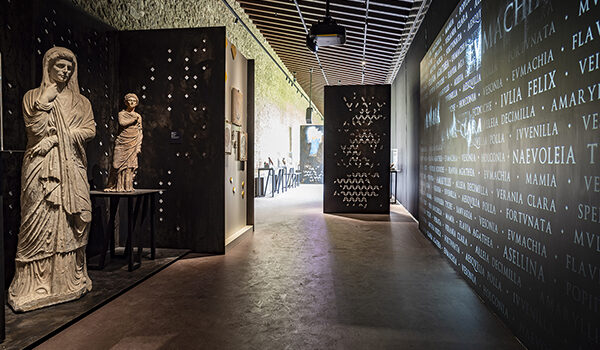“BEING A WOMAN IN POMPEII” – The exhibition in Palestra Grande in Pompeii From 16 April 2025 to 31 January 2026
Being a woman: a statement, but also a question to which there are different answers depending on the moment and the context, even in ancient Pompeii.
The discovery of the living conditions of women and girls, the numerous aspects of everyday life and the position they occupied in the house and Roman society, and even more so in a Campanian city such as Pompeii, is the thread running through the exhibition “Essere donna nell’antica Pompei” (Being a woman in Pompeii). The exhibition, which runs from 16 April 2025 to 31 January 2026 in Palestra Grande, is curated by Francesca Ghedini and Monica Salvadori and is organised in conjunction with the universities of Padua, Salerno and Verona.
Due to its extraordinary state of preservation, Pompeii represents a privileged vantage point. The finds that have emerged over almost three centuries of excavations provide a precious insight into the role of women in Roman society, a theme that in other contexts is inevitably neglected due to the paucity of the evidence. However, at Pompeii in particular, it is possible to discern the presence not only of women who belonged to the upper echelons of society but also the indistinct crowd of “ordinary” women who were the subject of the previous exhibition “L’altra Pompei” (The Other Pompeii), displaying thematic continuity.
The exhibition is divided into eight sections which, through displays of frescoes, private and funerary portraits, graffiti, inscriptions and everyday objects, shed light on the various categories of women - matrons, freed women and slaves - during the different phases of life: birth, childhood, marriage, maternity and death. The sections explore the various roles women played in society, ranging from activities of great social, economic and religious significance in which high-ranking matrons and nouveau riche freedwomen were involved, to trades of all kinds practised by freedwomen and slaves (spinners and weavers, vendors, innkeepers, bakers, doctors, sorceresses and prostitutes etc.).
In the first room, visitors are greeted with the names and faces of women in order to give a voice to their individuality.
The exhibition then goes on to illustrate, with the aid of the exceptional material evidence – statues, frescoes, inscriptions, graffiti and everyday objects– the women of Pompeii.
The first rooms reveal the main aspects of private life which, for a matron, included the organisation of domestic activities and relations with slaves, but also the education of children, body and skin care and leisure activities.
Considerable space is then devoted to the public and working lives of women. It is estimated that at Pompeii up to 100 women were involved in prostitution, many of them forced into it because they were enslaved, although this was not the case for all of them. Women were also responsible for highly prestigious activities with important social spin-offs, as emerges in the room devoted to women entrepreneurs and benefactors where there are stories of women who left a mark on their era, inaugurated new enterprises and initiatives, and changed the face of the city. The final traces of their earthly existence can be found in the necropolises, where funerary monuments, inscriptions and grave goods preserve the memory of some of these women.
The exhibition ends with a leap into the contemporary era which, on the one hand, presents the profiles of several women who made their own contribution to the discovery and knowledge of Pompeii (Carolina Bonaparte, Wilhelmina Jashemski, Tatiana Warsher and Olga Elia) and, on the other hand, provides visitors with a selection of film clips devoted to the female image taken from classic historical films inspired by Roman antiquity and, in particular, by Pompeii.
The context of the Archaeological Park of Pompeii makes it possible to extend the experience of the exhibition, transforming it into a themed tour. The exhibition does not culminate within the confines of Palestra Grande, but also suggests links with a series of major buildings in order to aid understanding of the condition of women in Pompeii. These buildings, which are marked at different points in the exhibition, help to create an immersive and interactive experience for visitors.
A further immersive element is provided by the thematic podcasts available on the app MyPompeii which recount stories of various women who actually lived in the city of Pompeii
It is possible to explore the stories of eight women, enabling visitors to meet the likes of Flavia Agatea and Eumachia at the tombs at Porta Nocera, Eumachia once again at the building of Eumachia in the Forum, Mamia and Nevoleia Tyche at the tombs at Porta Ercolano, Asellina at the Thermopolium of Asellina, Julia Felix in the Praedia of Julia Felix, Eutychis in the slave district of the House of the Vettii, and Amaryllis at the House of Marcus Terentius Eudoxus. Visitors can also see the reconstruction of a vertical loom, used in weaving, one of the female activities par excellence, in the House of the Marine Venus (Casa della Venere in Conchiglia).
The final aim is to create a complete cultural experience that combines past and present in a critical reflection on the role of women, providing tools that further understanding not just of the past but of the present as well.
Further information is available on: https://pompeiisites.org/mostre/essere-donna-nellantica-pompei/
Starting in September, during the extraordinary evening openings of the site – organised as part of the ESOPOP enhancement project – there will be a series of talks and artistic performances devoted to the women who are the protagonists of the exhibition. The festival is produced by Casa del Contemporaneo, while the texts and the direction are by Fabio Cocifoglia and Rosario Sparno.


